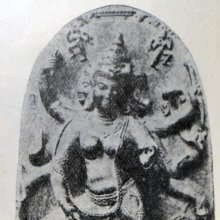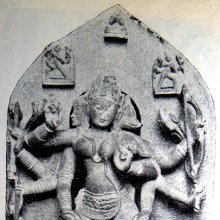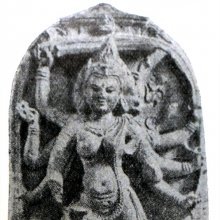Avahana, Āvahana, Āvāhana, Avāhana: 27 definitions
Introduction:
Avahana means something in Buddhism, Pali, Hinduism, Sanskrit, the history of ancient India, Marathi, Jainism, Prakrit, Hindi. If you want to know the exact meaning, history, etymology or English translation of this term then check out the descriptions on this page. Add your comment or reference to a book if you want to contribute to this summary article.
Images (photo gallery)
In Hinduism
Pancaratra (worship of Nārāyaṇa)
Source: archive.org: Isvara Samhita Vol 5Āvāhana (आवाहन) or Āvāhanamudrā is the name of a mudrā described in the Īśvarasaṃhitā 66.—Accordingly, “the right hand shall be slightly bent in the direction of the heart. The two thumbs shall be held apart and be more visible. This is the mudrā for invocation”. Mūdra (eg., Āvāha-mudrā) is so called as it gives joy to the tattvas in the form of karman for those who offer spotless worship, drive out the defects which move about within and without and sealing up of what is done.

Pancaratra (पाञ्चरात्र, pāñcarātra) represents a tradition of Hinduism where Narayana is revered and worshipped. Closeley related to Vaishnavism, the Pancaratra literature includes various Agamas and tantras incorporating many Vaishnava philosophies.
Shilpashastra (iconography)
Source: Shodhganga: The significance of the mūla-beras (śilpa)Āvāhana (आवाहन) and Utsavana refers to rituals involving dhruvaberas (consecrated images installed within the garbhagṛha of the temple).—The tirumañjanam (holy adoration) with oil, milk, and ghee is not performed for the dhruva-bera every day. Instead, the energies of the presiding deity are consecrated into another image called kautuka which is made out of metal and placed nearby. This ritual is called āvāhana. The energies that are transferred from the dhruva-bera to the kautuka every morning are again anchored back into the main deity every night. This is known as utsavana. Thus, the two rituals āvāhana and utsavana are carried out to the dhruva-bera every day.

Shilpashastra (शिल्पशास्त्र, śilpaśāstra) represents the ancient Indian science (shastra) of creative arts (shilpa) such as sculpture, iconography and painting. Closely related to Vastushastra (architecture), they often share the same literature.
Purana and Itihasa (epic history)
Source: archive.org: Shiva Purana - English TranslationĀvāhana (आवाहन, “invocation”) refers to one of the sixteen upacāra, or “sixteen types of homage and services”, as described while explaining the mode of worshipping the phallic form (liṅga) of Śiva in the Śivapurāṇa 1.11. Accordingly, “[...] the devotee shall worship the mobile emblem with the sixteen types of homage and services (upacāra) as prescribed. It accords the region of Śiva gradually. The sixteen types of service are [for example, invocation (āvāhana)] [...] Or he shall perform all the sixteen rites in the phallic emblem of human, saintly or godly origin, or in one naturally risen up (svayambhū) or in one of very extraordinary nature installed duly”.
Āvāhana (invocation) is mentioned in the Śivapurāṇa 1.20 while explaining the mode of worshipping an earthen phallic image (pārthiva-liṅga) according to the Vedic rites:—“[...] the invocation (āvāhana) shall be performed with the mantra “Mā no mahāntam” etc. The seating (upaveśana) shall be performed with the mantra “Yā te rudreṇa”.

The Purana (पुराण, purāṇas) refers to Sanskrit literature preserving ancient India’s vast cultural history, including historical legends, religious ceremonies, various arts and sciences. The eighteen mahapuranas total over 400,000 shlokas (metrical couplets) and date to at least several centuries BCE.
Shaivism (Shaiva philosophy)
Source: Shodhganga: Temple management in the ĀgamasĀvāhana (आवाहन) refers to certain a ceremony to be performed during pūjā (ritualistic worship), according to the Arcanāvidhipaṭala of Kāmikāgama.—After Sadāśivadhyāna [meditating on the form of Sadāśiva], the Ācārya performs mantranyāsa just as he did it on his own self. He creates a śaktiśarīra and invokes Śiva in that śarīra using the mūlamantra. He then meditates on that matchless, eternal Paraśiva who is sat-cit-ānanda-svarūpa, who is beyond measure, who is beyond reach of word and thought, who pervades through the universe just as word and its meaning, who pervades all the tattvas and who has manifested in the liṅga to bestow grace. The Aādhaka (Ācārya) then keeps chanting the prāsādamantra with bhakti while offering puṣpāñjali. He meditates on the Niṣkala-Śiva and visualizes his energy pervading the levels of nāda and bindu. Thus he performs āvāhana.

Shaiva (शैव, śaiva) or Shaivism (śaivism) represents a tradition of Hinduism worshiping Shiva as the supreme being. Closely related to Shaktism, Shaiva literature includes a range of scriptures, including Tantras, while the root of this tradition may be traced back to the ancient Vedas.
Dharmashastra (religious law)
Source: Oxford Academic: Homo Ritualis: Hindu Ritual and Its Significance to Ritual TheoryĀvāhana (आवाहन) refers to “make a ritual invocation” and represents one of the elements of Newar rituals.—Books such as the Daśakarmavidhi detail on the most common rules to be followed by the Newar priests, the priest’s clients, or the clan’s oldest men or women who are mostly ritually responsible for the ritual, and the individual(s) for whom the life-cycle ritual is performed.—The Āvāhana rite is mentioned under the heading “Preliminary rites”.

Dharmashastra (धर्मशास्त्र, dharmaśāstra) contains the instructions (shastra) regarding religious conduct of livelihood (dharma), ceremonies, jurisprudence (study of law) and more. It is categorized as smriti, an important and authoritative selection of books dealing with the Hindu lifestyle.
General definition (in Hinduism)
Source: ACHC: Smarta PujaĀvāhana (आवाहन) refers to “invocation”, representing one of the various services (upacāra) of a pūjā (ritualistic worship of a deity) which aim at the purification of the devotee.—The pūjā begins with the invocation (āvāhana), for which the first mantra of the Puruṣa-sūkta is employed. Āvāhana is not done: 1. in case of Viṣṇu being worshipped in the śālagrāma stone or Śiva being worshipped in the bāṇa-liṅga, or 2. in case of icons which have been permanently established in temples.
In case of temporarily worshipped icons of clay etc. the āvāhana follows the rite of prāṇa-pratiṣṭha by which the deity is made to be present in the icon. Modern informants interpret āvāhana in that case as a request to the deity to be ready to accept the pūjā which is being offered.
Source: Shodhganga: Temples and cult of Sri Rama in Tamilnadu (h)Avahana refers to “invoking presence of the God” and represents one of the various daily ceremonies performed during puja (worship).—Offering of water and food or tirtham and prasadam to the deities on the different occasions or specified hours of the day is an important item in the daily pujas. [...] While for the daily routine, only ordinary plain rice was offered, special food preparations were offered often on festival days. [...] The daily routine includes a number of ceremonies [viz., Avahana] that are repeated.
Source: academia.edu: Tessitori Collection I (hinduism)Āvāhana (आवाहन) refers to one of the topics dealt with in the Devīmāhātmya (dealing with Hymns and Rituals), which is included in the collection of manuscripts at the ‘Vincenzo Joppi’ library, collected by Luigi Pio Tessitori during his visit to Rajasthan between 1914 and 1919.—The manuscript of the Devīmāhātmya contains the following material: [e.g., āvāhana]. the main part of the Devīmāhātmya is made of three main episodes which are tales of the goddess’s divine exploits: Madhu and Kaiṭabha; Mahiṣāsura; Śumbha and Niśumbha. Then come the Gods’ praises, followed by prophecies of the goddess on her future intervention in the world, and an account of the merit gained by reciting the text. [...]
In Buddhism
Mahayana (major branch of Buddhism)
Source: De Gruyter: A Buddhist Ritual Manual on AgricultureĀvāhana (आवाहन) refers to “invitation” (as part of an offering ritual), according to the Vajratuṇḍasamayakalparāja, an ancient Buddhist ritual manual on agriculture from the 5th-century (or earlier), containing various instructions for the Sangha to provide agriculture-related services to laypeople including rain-making, weather control and crop protection.—Accordingly, [as the Bhagavān teaches the offering of the root spell], “[...] Having placed a Nāga facing east, the spell-master should sit down facing that, and should perform invitation (āvāhana), offering of flower and incense and dismissal with the mantra. Then the spell-master should do recitation for 1,008 times. [...]”.

Mahayana (महायान, mahāyāna) is a major branch of Buddhism focusing on the path of a Bodhisattva (spiritual aspirants/ enlightened beings). Extant literature is vast and primarely composed in the Sanskrit language. There are many sūtras of which some of the earliest are the various Prajñāpāramitā sūtras.
India history and geography
Source: Yale Journal of Music & Religion: Ritual Music in Contemporary Brahmanical Tantric Temples of KeralaĀvāhana (आवाहन) refers to the “invocation” of the deity.—Daily pūjā in Kerala includes several phases. [...] One worships the seat on which the icon sits and proceeds with the invocation (āvāhana) of the deity onto it. This is done by transfusing a fragment of the priest’s consciousness into the idol. He takes flowers along with water from the conch in his joined hands positioned near mūlādhāra-cakra, where Kuṇḍalinī is believed to reside. Then, by reciting mantras, he imaginatively raises his consciousness through the central channel (suṣumnā) to the cakra of the heart and up to the sahasrāra-cakra above the head, where he joins the fragment of his consciousness with the supreme self that is situated there. Reciting the mantra of the deity, he invokes his/her presence (āvāhana), conducts it in the form of breath into the flowers and water he keeps in his hands, and pours all of them over the head of the idol. [...]

The history of India traces the identification of countries, villages, towns and other regions of India, as well as mythology, zoology, royal dynasties, rulers, tribes, local festivities and traditions and regional languages. Ancient India enjoyed religious freedom and encourages the path of Dharma, a concept common to Buddhism, Hinduism, and Jainism.
Languages of India and abroad
Pali-English dictionary
Source: BuddhaSasana: Concise Pali-English Dictionaryāvahana : (nt.) (in cpds.), bringing; bearing; conducive. || āvāhana (nt.) taking in marriage; wedding.
Source: Sutta: The Pali Text Society's Pali-English DictionaryĀvāhana, (nt.) (ā + vshana, of vah) — 1. = āvāha, i.e. marriage, taking a wife D. I, 11 (= āvāha-karaṇa DA. I, 96).—2. “getting up, bringing together”, i.e. a mass, a group or formation, in senā° a contingent of an army J. IV, 91. (Page 112)
— or —
Āvahana, (adj) (-°) (= āvaha) bringing, causing Th. 1, 519; Sn. 256. (Page 112)

Pali is the language of the Tipiṭaka, which is the sacred canon of Theravāda Buddhism and contains much of the Buddha’s speech. Closeley related to Sanskrit, both languages are used interchangeably between religions.
Marathi-English dictionary
Source: DDSA: The Molesworth Marathi and English Dictionaryāvāhana (आवाहन).—n S Summoning or invoking (a divinity to occupy an image just prepared to receive him, or to enter into any object, when, for the due performance of some rite or ceremony, his presence is required). 2 Summoning or calling.
Source: DDSA: The Aryabhusan school dictionary, Marathi-Englishāvāhana (आवाहन).—n Invoking; calling.
Marathi is an Indo-European language having over 70 million native speakers people in (predominantly) Maharashtra India. Marathi, like many other Indo-Aryan languages, evolved from early forms of Prakrit, which itself is a subset of Sanskrit, one of the most ancient languages of the world.
Sanskrit dictionary
Source: DDSA: The practical Sanskrit-English dictionaryAvāhana (अवाहन).—a. Having no carriage, not driving in a carriage.
--- OR ---
Āvahana (आवहन).—Bringing near, producing.
Derivable forms: āvahanam (आवहनम्).
--- OR ---
Āvāhana (आवाहन).—
1) Sending for, inviting, calling.
2) Invoking a deity (to be present) (opp. visarjana); आवाहने विनियोगः, आवाहनं न जानामि न जानामि तवार्चनम् (āvāhane viniyogaḥ, āvāhanaṃ na jānāmi na jānāmi tavārcanam) Pūjā Mantra.
3) Offering oblations to fire; आवाहनाग्नौकरणरहितं ह्यपसव्यवत् (āvāhanāgnaukaraṇarahitaṃ hyapasavyavat) Y.1.251.
-nī A particular position of the hands at the time of invoking a deity; हस्ताभ्यामञ्जलिं बद्ध्वाऽनामिका- मूलपर्वणोः । अङ्गुष्ठौ निक्षिपेत्सेयं मुद्रा त्वावाहनी स्मृता (hastābhyāmañjaliṃ baddhvā'nāmikā- mūlaparvaṇoḥ | aṅguṣṭhau nikṣipetseyaṃ mudrā tvāvāhanī smṛtā) || Śabdak.
Derivable forms: āvāhanam (आवाहनम्).
Source: Cologne Digital Sanskrit Dictionaries: Shabda-Sagara Sanskrit-English DictionaryĀvāhana (आवाहन).—n.
(-naṃ) 1. Calling. 2. Inviting. 3. Offering oblations with fire. f. (-nī) A particular position of the hands or the palms put together, and the thumbs put at the root of the ring finger. E. āṅ before vah to bear, causal form, lyuṭ aff.
Source: Cologne Digital Sanskrit Dictionaries: Benfey Sanskrit-English DictionaryĀvāhana (आवाहन).—i. e. ā-vah + ana, n. Invitation.
Source: Cologne Digital Sanskrit Dictionaries: Cappeller Sanskrit-English DictionaryĀvahana (आवहन).—[neuter] bringing near.
Source: Cologne Digital Sanskrit Dictionaries: Aufrecht Catalogus CatalogorumĀvāhana (आवाहन) as mentioned in Aufrecht’s Catalogus Catalogorum:—śr. Oudh. Xvi, 2. 4. Xix, 40.
Source: Cologne Digital Sanskrit Dictionaries: Monier-Williams Sanskrit-English Dictionary1) Avāhana (अवाहन):—[=a-vāhana] mfn. having no vehicle or carriage, not driving in a carriage, [Śatapatha-brāhmaṇa iv.]
2) Āvahana (आवहन):—[=ā-vahana] [from ā-vah] n. bringing near.
3) Āvāhana (आवाहन):—[=ā-vāhana] [from ā-vah] n. sending for, inviting, calling, [Yājñavalkya; Viṣṇu-purāṇa; Varāha-mihira’s Bṛhat-saṃhitā]
4) [v.s. ...] invocation, invitation
Source: Cologne Digital Sanskrit Dictionaries: Yates Sanskrit-English DictionaryĀvāhana (आवाहन):—[ā-vāhana] (naṃ) 1. n. A calling.
Source: DDSA: Paia-sadda-mahannavo; a comprehensive Prakrit Hindi dictionary (S)Āvāhana (आवाहन) in the Sanskrit language is related to the Prakrit word: Āvāhaṇa.
[Sanskrit to German]
Sanskrit, also spelled संस्कृतम् (saṃskṛtam), is an ancient language of India commonly seen as the grandmother of the Indo-European language family (even English!). Closely allied with Prakrit and Pali, Sanskrit is more exhaustive in both grammar and terms and has the most extensive collection of literature in the world, greatly surpassing its sister-languages Greek and Latin.
Hindi dictionary
Source: DDSA: A practical Hindi-English dictionaryĀvāhana (आवाहन) [Also spelled avahan]:—(nm) invocation (of a deity etc.); a call; summoning.
...
Prakrit-English dictionary
Source: DDSA: Paia-sadda-mahannavo; a comprehensive Prakrit Hindi dictionary1) Avahāṇa (अवहाण) in the Prakrit language is related to the Sanskrit word: Avadhāna.
2) Āvāhaṇa (आवाहण) also relates to the Sanskrit word: Āvāhana.
Prakrit is an ancient language closely associated with both Pali and Sanskrit. Jain literature is often composed in this language or sub-dialects, such as the Agamas and their commentaries which are written in Ardhamagadhi and Maharashtri Prakrit. The earliest extant texts can be dated to as early as the 4th century BCE although core portions might be older.
Kannada-English dictionary
Source: Alar: Kannada-English corpusĀvahana (ಆವಹನ):—[noun] = ಆವಾಹನೆ [avahane].
--- OR ---
Āvāhana (ಆವಾಹನ):—[noun] = ಆವಾಹನೆ [avahane].
Kannada is a Dravidian language (as opposed to the Indo-European language family) mainly spoken in the southwestern region of India.
See also (Relevant definitions)
Starts with: Avahanaka, Avahanamgey, Avahanamudra, Avahanamudre, Avahanana, Avahanavidhana, Avahanavisarjana.
Ends with (+131): Abdavahana, Abjavahana, Adhyavahana, Amitavahana, Anabhogavahana, Anantavahana, Aparishrotavahana, Apavahana, Ashvavahana, Atibharavahana, Atitavahana, Balavahana, Barhinavahana, Bhagapavahana, Bhakadavahana, Bharavahana, Bhutavahana, Bijavahana, Candravahana, Chagavahana.
Full-text (+19): Avadhana, Avahanaka, Avakanamuttirai, Avahanem, Avhana, Shodashopacara, Avaki, Avahan, Avahani, Vivahana, Utsavana, Abbhahana, Yogasana, Adhyavahana, Avahanavisarjana, Nitya, Kaka, Upaveshana, Tirthashraddha, Padmasana.
Relevant text
Search found 24 books and stories containing Avahana, A-vahana, A-vāhana, Ā-vahana, Ā-vāhana, Āvahana, Āvāhana, Avāhana, Avahāṇa, Āvāhaṇa; (plurals include: Avahanas, vahanas, vāhanas, Āvahanas, Āvāhanas, Avāhanas, Avahāṇas, Āvāhaṇas). You can also click to the full overview containing English textual excerpts. Below are direct links for the most relevant articles:
Chaitanya Bhagavata (by Bhumipati Dāsa)
Verse 1.1.44 < [Chapter 1 - Summary of Lord Gaura’s Pastimes]
Verse 2.6.110 < [Chapter 6 - The Lord’s Meeting with Advaita Ācārya]
Matangalila and Hastyayurveda (study) (by Chandrima Das)
Elephants in Śaktism < [Chapter 4]
Sankhayana-grihya-sutra (by Hermann Oldenberg)
Brihad Bhagavatamrita (commentary) (by Śrī Śrīmad Bhaktivedānta Nārāyana Gosvāmī Mahārāja)
Verse 2.4.211 < [Chapter 4 - Vaikuṇṭha (the spiritual world)]
Dvisahasri of Tembesvami (Summary and Study) (by Upadhyay Mihirkumar Sudhirbhai)
Satapatha-brahmana (by Julius Eggeling)
Kāṇḍa I, adhyāya 6, brāhmaṇa 1 < [First Kāṇḍa]
Kāṇḍa I, adhyāya 4, brāhmaṇa 2 < [First Kāṇḍa]
Kāṇḍa I, adhyāya 7, brāhmaṇa 3 < [First Kāṇḍa]
Related products




